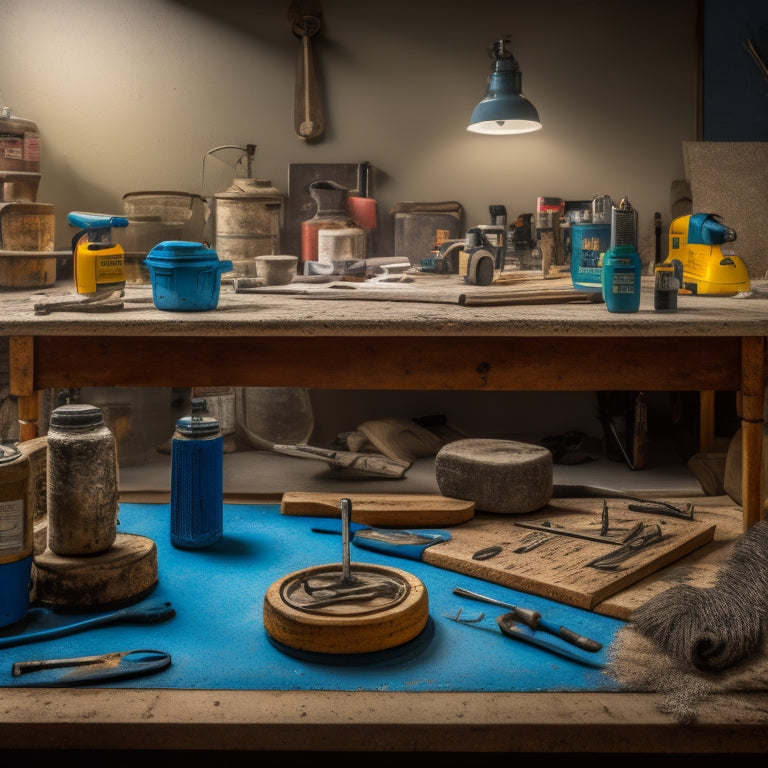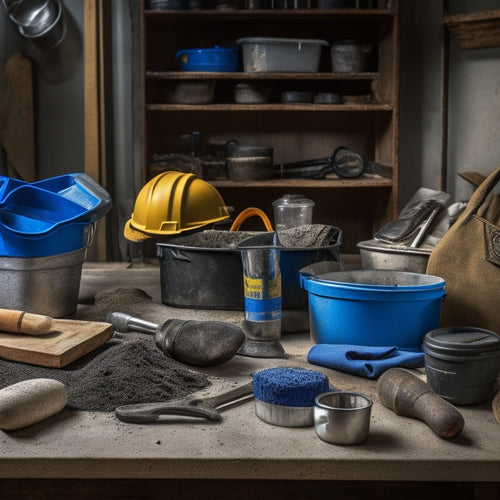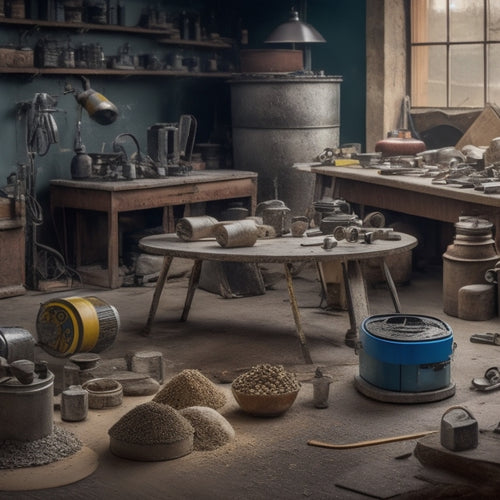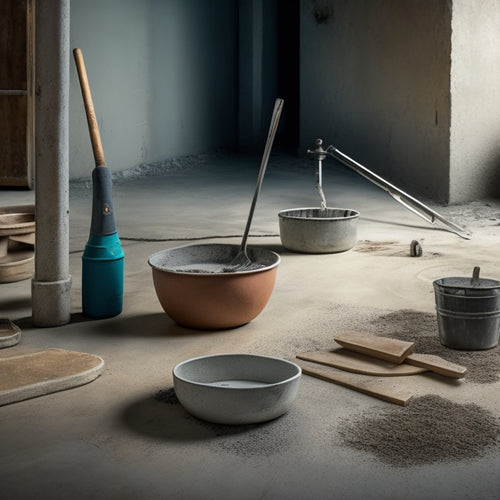
Why You Need These Stamped Concrete Tools
Share
You need the right stamped concrete tools to achieve professional-looking results, as a single mistake in texture, pattern, or design can drastically affect the overall aesthetic appeal of your project. Mastering texture and pattern control, creating intricate design elements, and achieving realistic stone impressions require appropriate tool selection. Precision and edge control, working with different mat sizes, and perfecting color and hue consistency are also essential. With the right tools, you can efficiently cut and shape, smooth out rough edges, and guarantee durable finish coats. Now, explore the nuances of each tool to access the full potential of your stamped concrete projects.
Key Takeaways
• Mastering texture, pattern, and design requires the right tools for desired results, ensuring professional-looking stamped concrete.
• Precision and edge control are crucial for achieving sharp edges and lines, enhancing overall aesthetic appeal.
• Mat size and pattern variation are essential for creating unique and complex designs, offering a range of pattern options.
• Color and finish techniques impact the final appearance and durability of stamped concrete, making quality tools vital.
• Cutting and shaping techniques bring design visions to life, requiring precision, attention to detail, and high-quality tools.
Mastering Texture and Pattern Control
To achieve professional-looking stamped concrete results, you must master the art of texture and pattern control, which involves carefully selecting and expertly using the right tools to create the desired design.
This requires a deep understanding of texture techniques and pattern precision. You'll need to choose tools that can produce the desired texture and pattern, whether it's a rustic stone look or a modern geometric design.
For instance, you'll need to select the right stamp mats, which come in various textures and patterns. These mats will help you achieve the desired pattern precision, ensuring that your design is consistent and uniform.
You'll also need to take into account the type of release agents to use, as they can affect the final texture and appearance of your concrete.
Achieving Realistic Stone Impressions
Achieving Realistic Stone Impressions
Your stamp mat selection plays an essential role in achieving realistic stone impressions, as the right mat can convincingly mimic the texture and pattern of natural stone. When choosing a stamp mat, look for ones with intricate details and varying impression depths to create a more authentic look.
Impression depth variations will help you achieve a more realistic stone texture, as natural stone often has subtle variations in depth and pattern.
To further enhance the realism of your stone impressions, master various stone texture techniques. For instance, you can use a combination of heavy and light stamping to create a more organic, natural look.
You can also experiment with different stamping patterns and directions to mimic the unique characteristics of specific types of stone.
Creating Intricate Design Elements
When creating intricate design elements in stamped concrete, you'll need to contemplate the right combination of pattern and texture options to achieve the desired look.
You'll also want to select the appropriate stamping mat designs to complement your chosen pattern, and decide on color accenting techniques to add depth and visual interest.
Pattern and Texture Options
Selecting the right pattern and texture options allows you to create intricate design elements that elevate your stamped concrete projects, giving them a unique, high-end look. With various stamped patterns to choose from, you can replicate the appearance of natural stone, brick, or wood, adding visual interest to your projects. Textured finishes, on the other hand, provide an added layer of realism, making your stamped concrete surfaces feel like the real thing.
When it comes to pattern selection, you'll want to evaluate the style and theme of your project. For example, a rustic, wood-grain pattern might work well for a rural or mountainous setting, while a sleek, stone-inspired pattern could be more suitable for a modern, urban environment.
Texture options can also be used to enhance the overall aesthetic, with choices ranging from subtle, rough-hewn finishes to more dramatic, heavily textured effects.
Stamping Mat Designs
You can create intricate design elements by combining stamping mat designs in various ways, allowing you to add unique features to your stamped concrete projects.
By mixing and matching different mat patterns, you can achieve complex designs that elevate the aesthetic appeal of your work. Innovative mat materials have made it possible to replicate natural textures, such as wood and stone, with uncanny accuracy. This versatility enables you to keep up with seasonal design trends, incorporating elements that are fresh and on-trend into your projects.
When selecting stamping mat designs, consider the overall theme and style you're aiming to achieve. For instance, if you're working on a project with a rustic, outdoor feel, you might choose mats with a wood-grain or stone texture.
Alternatively, if you're working on a modern, urban design, you might opt for mats with a sleek, geometric pattern. By combining different mats in creative ways, you can create one-of-a-kind designs that set your work apart from the rest.
With the right tools and a little creativity, the possibilities are endless.
Color Accenting Techniques
By incorporating color accenting techniques into your stamped concrete projects, you can add an extra layer of visual interest and create intricate design elements that draw the eye. This involves strategically using different colors to highlight specific design features or create contrasting visual effects.
One popular accent technique is color blending, where you gradate two or more colors to create a seamless changeover between them. This can be used to create realistic stone or wood textures, or to add depth and dimension to your design.
To achieve professional-looking results, you'll need the right tools and materials. Invest in a range of concrete stains and tints, as well as specialized brushes and applicators designed specifically for color accenting.
Practice makes perfect, so don't be discouraged if it takes a few tries to get the hang of it. With patience and practice, you can master color accenting techniques and take your stamped concrete projects to the next level.
Getting Sharp Edges and Lines
To achieve sharp edges and lines in stamped concrete, use an edger or a jointer to create a defined border around the pattern. These edge finishing techniques will help you achieve a crisp, clean look that sets your work apart.
When it comes to line precision tools, you'll want to invest in a high-quality edger or jointer that can handle the job. With the right tool, you'll be able to create sharp, defined edges that add depth and visual interest to your design.
Whether you're working on a small patio or a large commercial project, edge finishing techniques are essential for achieving a professional look. By using a jointer or edger, you'll be able to create smooth, consistent lines that add to the overall aesthetic of your stamped concrete design.
Working With Different Mat Sizes
When working with stamped concrete, you'll need to choose the right mat size to achieve the desired pattern and texture.
You'll have various mat size options to select from, ranging from small, detailed designs to larger, more sweeping patterns.
Mat Size Options
You'll encounter various mat sizes, ranging from 2x2 feet to 6x6 feet, which require adaptations in your stamping technique to achieve consistent patterns. Each mat size has its benefits and considerations, and understanding these factors will help you choose the right tool for the job.
Mat Size Benefits:
-
Flexibility: Larger mats (4x4 feet or 6x6 feet) provide more coverage, allowing you to complete projects faster. They're ideal for open areas with minimal obstructions.
-
Details: Smaller mats (2x2 feet or 3x3 feet) offer more precision, making them perfect for intricate designs, borders, and tight spaces.
-
Versatility: Mid-range mats (3x3 feet or 4x4 feet) provide a balance between coverage and precision, making them suitable for most projects.
When working with different mat sizes, consider the project's scale, design complexity, and your personal comfort level.
By selecting the right mat size, you'll achieve professional-looking results and optimize your workflow.
Remember to adjust your stamping technique accordingly to guarantee consistent patterns and a high-quality finish.
Mat Pattern Variety
Different mat sizes offer a wide range of pattern variety, and by mastering their unique characteristics, you can access a diverse array of designs and textures to elevate your stamped concrete projects.
Working with different mat sizes allows you to experiment with various pattern combinations, creating unique and complex designs that showcase your craftsmanship. For instance, using smaller mats enables you to create intricate, detailed patterns, while larger mats provide a broader canvas for bold, statement-making designs.
Staying on top of mat pattern trends is essential to delivering high-quality results. Follow industry leaders and designers for mat pattern inspiration, and experiment with different mat sizes to develop your own signature style.
By doing so, you'll be able to offer clients a wide range of design options, from modern and sleek to traditional and ornate. Remember, the key to success lies in understanding the strengths and limitations of each mat size, and using that knowledge to push the boundaries of stamped concrete design.
With practice and patience, you'll be able to reveal the full potential of your mats and take your projects to the next level.
Perfecting Color and Hue Consistency
Achieving consistent color and hue in stamped concrete requires precise control over the variables that affect pigment distribution, starting with the quality of your integral color or color hardener. You need to guarantee that your color products are compatible with your concrete mix design and that you're using the correct amount of water to achieve the desired color intensity.
To perfect your color and hue consistency, follow these best practices:
-
Color blending: Invest in a high-quality color blender that allows you to accurately measure and mix your integral color or color hardener. This guarantees that your color is consistent throughout the entire pour.
-
Hue adjustment: Keep a range of color adjusters on hand to fine-tune your color as needed. This is especially important when working with complex color schemes or when you need to make last-minute adjustments.
-
Consistent application: Develop a standardized application process that guarantees your color is applied evenly and consistently across the entire surface. This can be achieved through proper training and quality control measures.
Efficiently Cutting and Shaping
With a consistent color scheme in place, you can now focus on efficiently cutting and shaping your stamped concrete to achieve the desired pattern and design.
This stage requires precision and attention to detail to guarantee your finished product looks professional. You'll need to employ various cutting techniques, such as saw cutting, grinding, or chiseling, depending on the complexity of your design. Having the right shaping tools at your disposal is essential to achieve clean, crisp lines and curves.
Invest in a set of high-quality shaping tools, including trowels, edgers, and jointers, designed specifically for stamped concrete. These tools will help you achieve precise control over the concrete, allowing you to create intricate patterns and designs.
For more complex cuts, consider using a concrete saw or a diamond blade grinder. By mastering cutting and shaping techniques and using the right tools, you'll be able to bring your design vision to life and create a stunning, one-of-a-kind stamped concrete surface.
Smoothening Out Rough Edges
You'll need to address any rough edges or burrs that formed during the cutting and shaping process to secure a smooth, even finish. This vital step guarantees that your stamped concrete project looks professional and polished. To achieve this, you'll need to employ effective edge finishing techniques and surface preparation methods.
Here are three essential tools to help you smoothen out rough edges:
-
Edge grinder: A handheld edge grinder is perfect for removing small burrs and imperfections. Its compact design allows you to access tight spaces and corners.
-
Diamond sanding pads: These pads are designed for aggressive material removal and can be used to smooth out rough edges. They come in various grits, allowing you to progress from coarse to fine.
-
Rubberized sanding blocks: For a finer finish, use rubberized sanding blocks to remove any remaining scratches or marks. They're also great for rounding over sharp edges.
Ensuring Durable Finish Coats
To guarantee your stamped concrete project withstands the test of time, applying durable finish coats is vital, as they protect the surface from environmental elements and heavy foot traffic.
You'll want to make certain a strong finish coat application that can resist wear and tear.
When choosing a finish coat, consider using protective sealers that not only enhance the appearance of your stamped concrete but also provide a barrier against the elements.
Acrylic sealers, for instance, offer excellent protection against UV rays and water exposure. Silane-based sealers, on the other hand, provide superior resistance to oil and chemical spills.
Regardless of the type of sealer you choose, make sure to follow the manufacturer's instructions for application and drying times.
It's also essential to prepare the surface properly before applying the finish coat, ensuring it's clean, dry, and free of any debris.
Frequently Asked Questions
Can I Use Stamped Concrete Tools on Existing Concrete Surfaces?
You're wondering if you can use stamped concrete tools on existing concrete surfaces. The short answer is yes, but with caution.
For successful stamped concrete applications, proper surface preparation is key. Confirm the surface is clean, dry, and free of cracks or damages.
If necessary, apply a bonding agent to create a strong bond between the old and new concrete.
Then, you can use stamped concrete tools to achieve the desired texture and pattern.
Do I Need Special Training to Use Stamped Concrete Tools?
You're about to release your creativity on a concrete project, but first, you're wondering... do you need special training to use stamped concrete tools?
The answer is, it depends on your level of experience.
While formal training isn't necessary, you'll need to take safety precautions and choose the right tools for the job.
Proper tool selection is essential to achieve the desired pattern and avoid accidents.
Are Stamped Concrete Tools Suitable for Indoor Projects?
When it comes to indoor projects, you'll be pleased to know that stamped concrete tools are more than suitable.
They offer a range of stamped concrete benefits, allowing you to create unique indoor design elements that mimic natural materials like wood, stone, or brick.
With the right tools, you can achieve intricate patterns, textures, and colors that will elevate your indoor space.
How Do I Clean and Maintain My Stamped Concrete Tools?
To keep your stamped concrete tools in top shape, you'll need to clean and maintain them regularly.
Start by wiping down each tool with a soft cloth to remove excess concrete and debris.
Then, use mild soap and warm water to scrub away any stubborn stains.
After cleaning, dry your tools thoroughly and store them in a dry, protected area to prevent rust.
Consider investing in tool storage solutions like cases or bags to keep your tools organized and within reach.
Are Stamped Concrete Tools Expensive to Purchase or Rent?
Finding the right stamped concrete tools can be like searching for a needle in a haystack - overwhelming.
Are they expensive to purchase or rent? When considering the cost, you'll find that buying high-quality tools might seem steep upfront, but it's a long-term investment.
On the other hand, rental options can be a cost-effective alternative, especially for one-time projects.
Conduct a cost comparison to determine what works best for you and your budget.
Conclusion
With these stamped concrete tools in your arsenal, you're on the cusp of revealing unparalleled mastery over your craft.
Texture and pattern control are within your grasp, realistic stone impressions await, and intricate design elements are mere minutes away.
But that's not all - sharp edges, precise lines, and durable finish coats are also within reach.
The question is, what'll you create first?
Related Posts
-

5 Tools Needed for Quick Fix Concrete Mixing
You'll need five essential tools to tackle a quick fix concrete mixing project efficiently. First, you'll require a s...
-

Top DIY Concrete Grinding and Polishing Tools
When selecting DIY concrete grinding and polishing tools, you'll want to take into account a range of factors to guar...
-

Why You Need These Concrete Overlay Tools
When tackling a concrete overlay project, you need the right tools to achieve a flawless finish and avoid costly mist...


